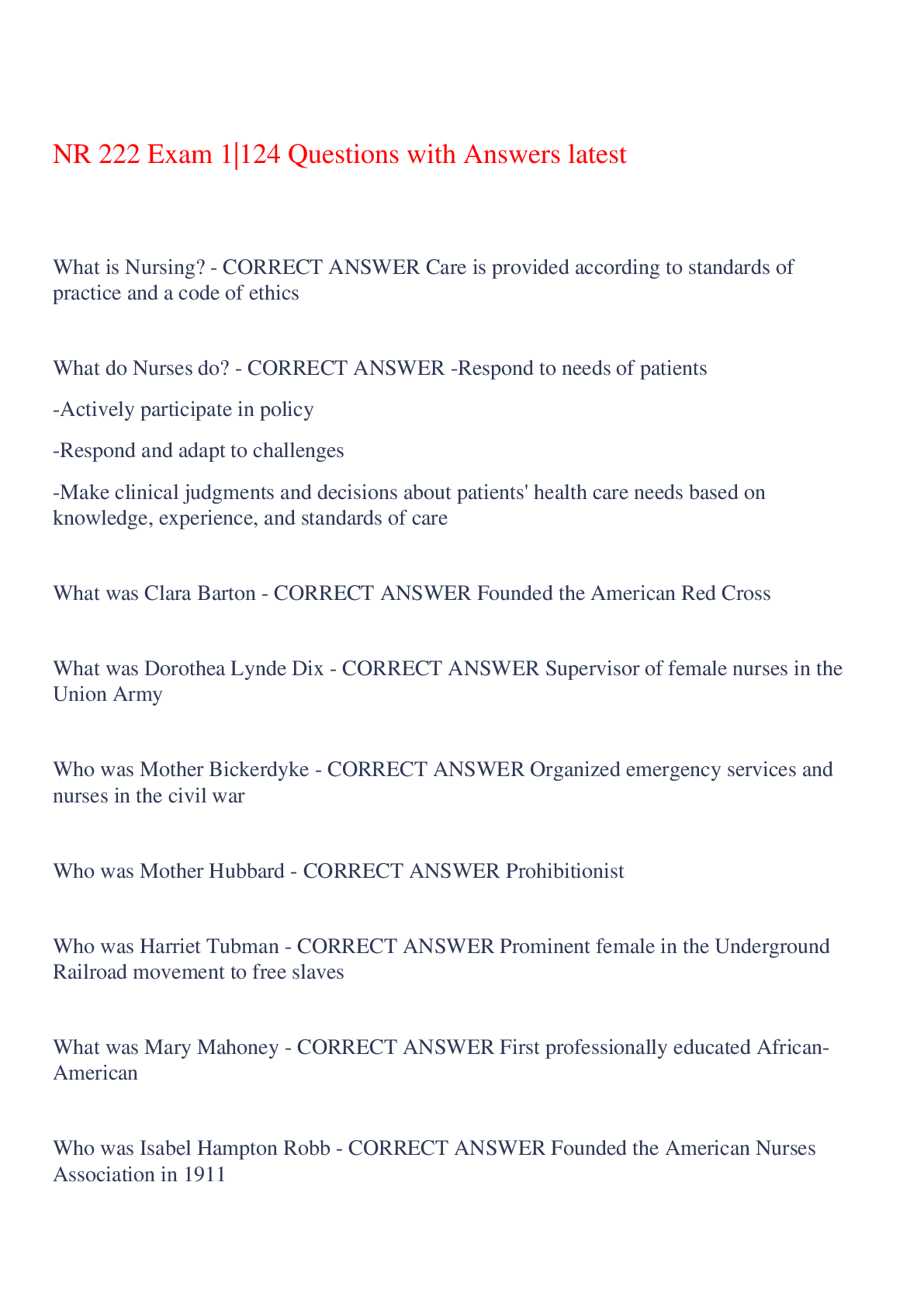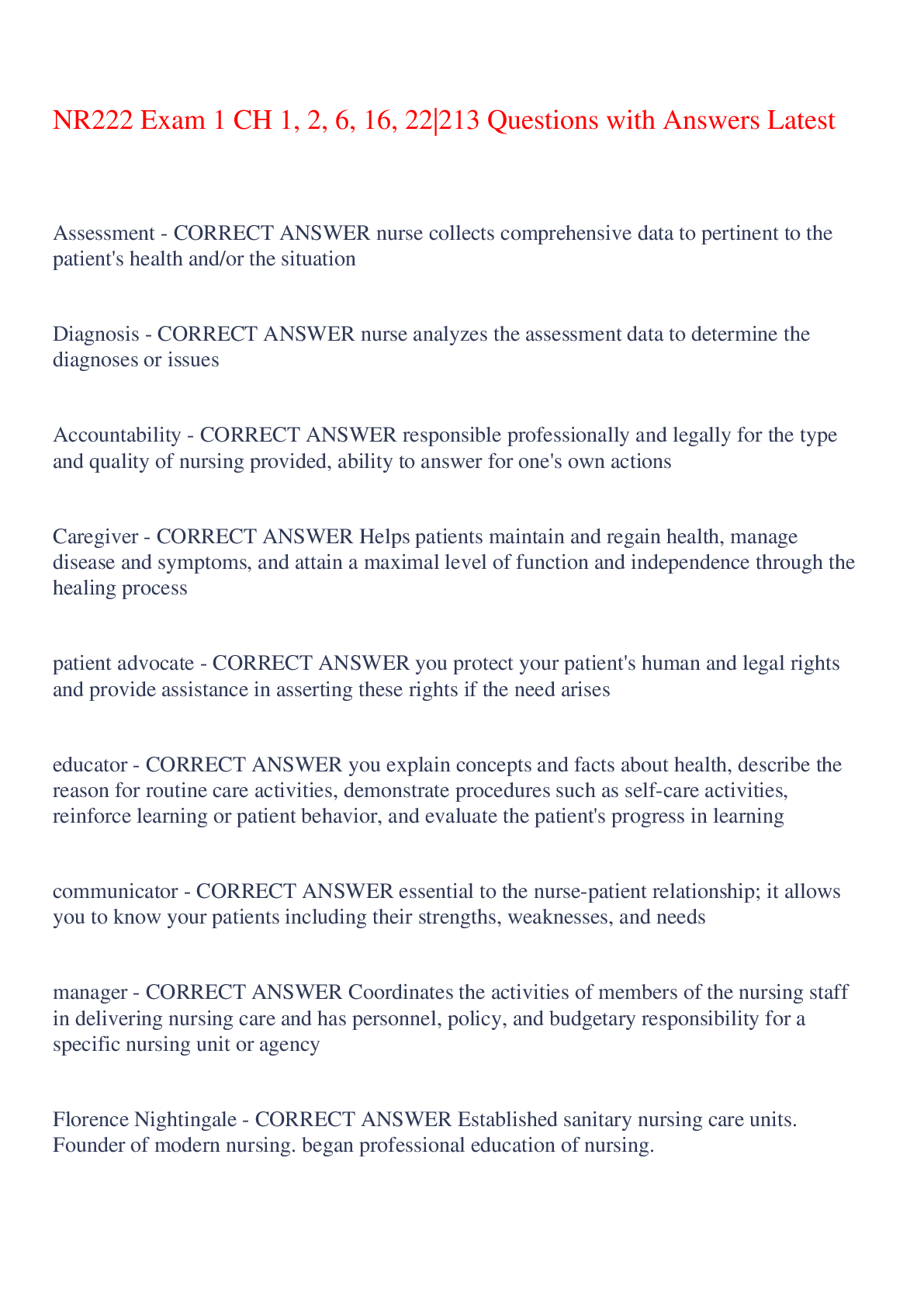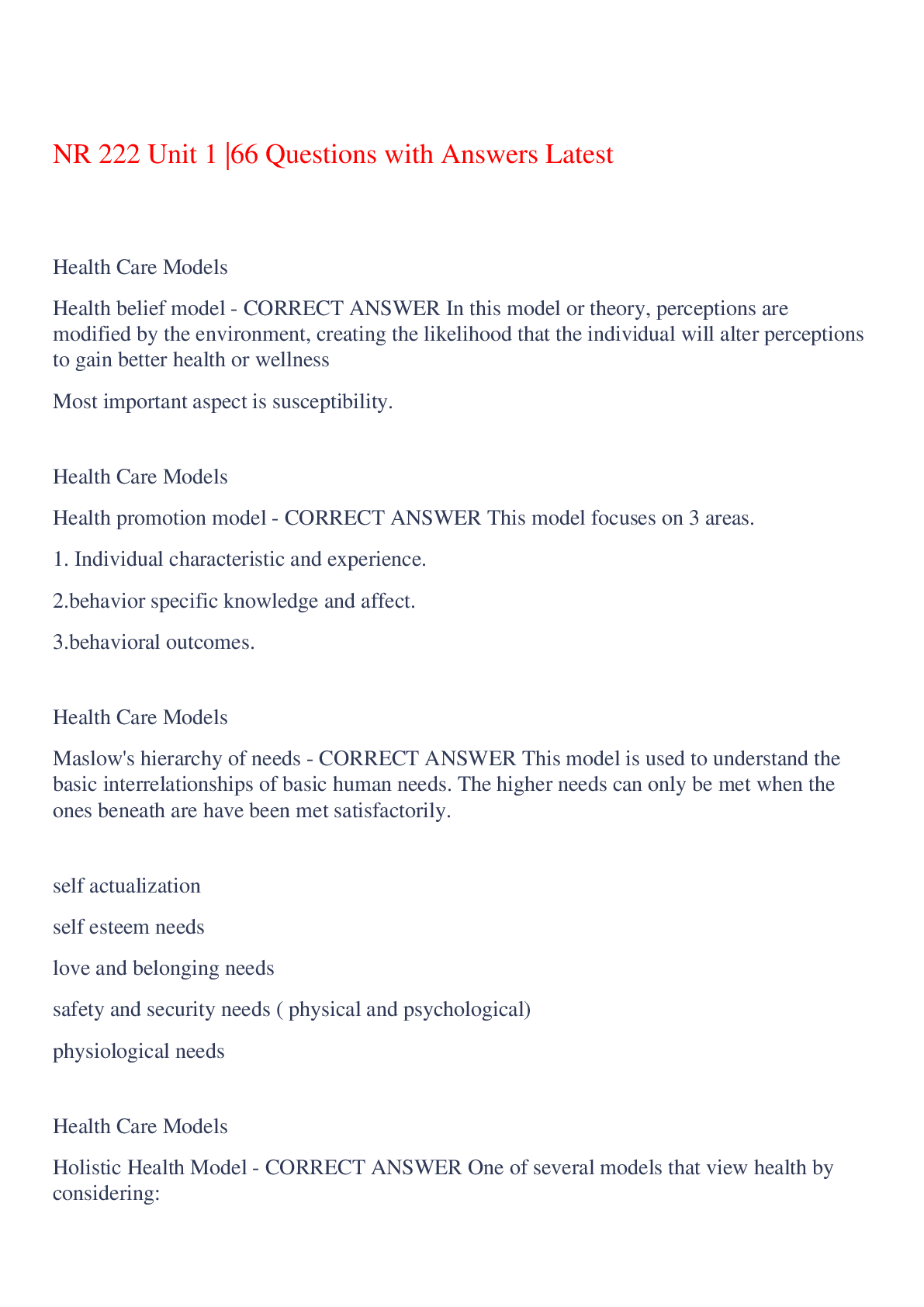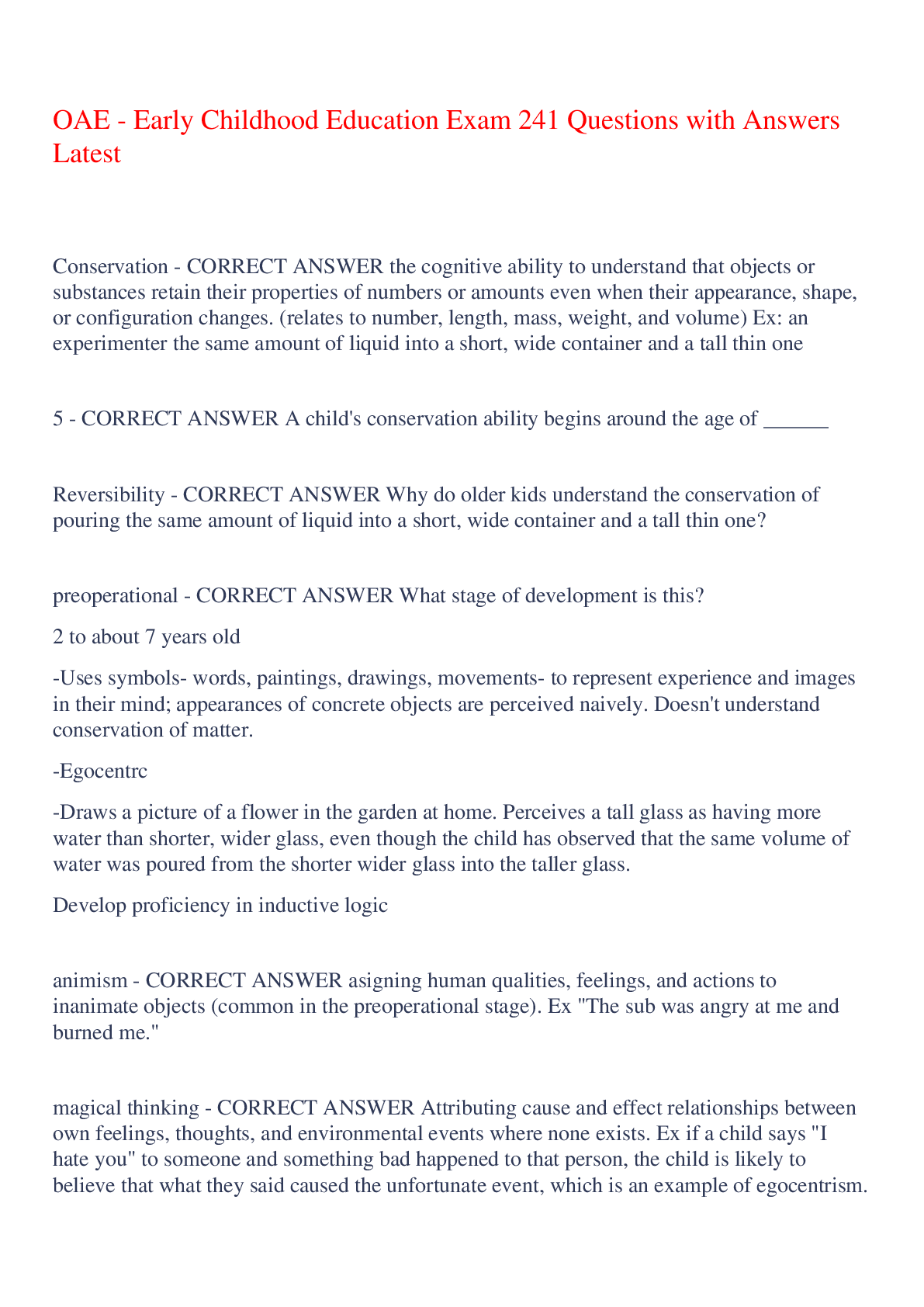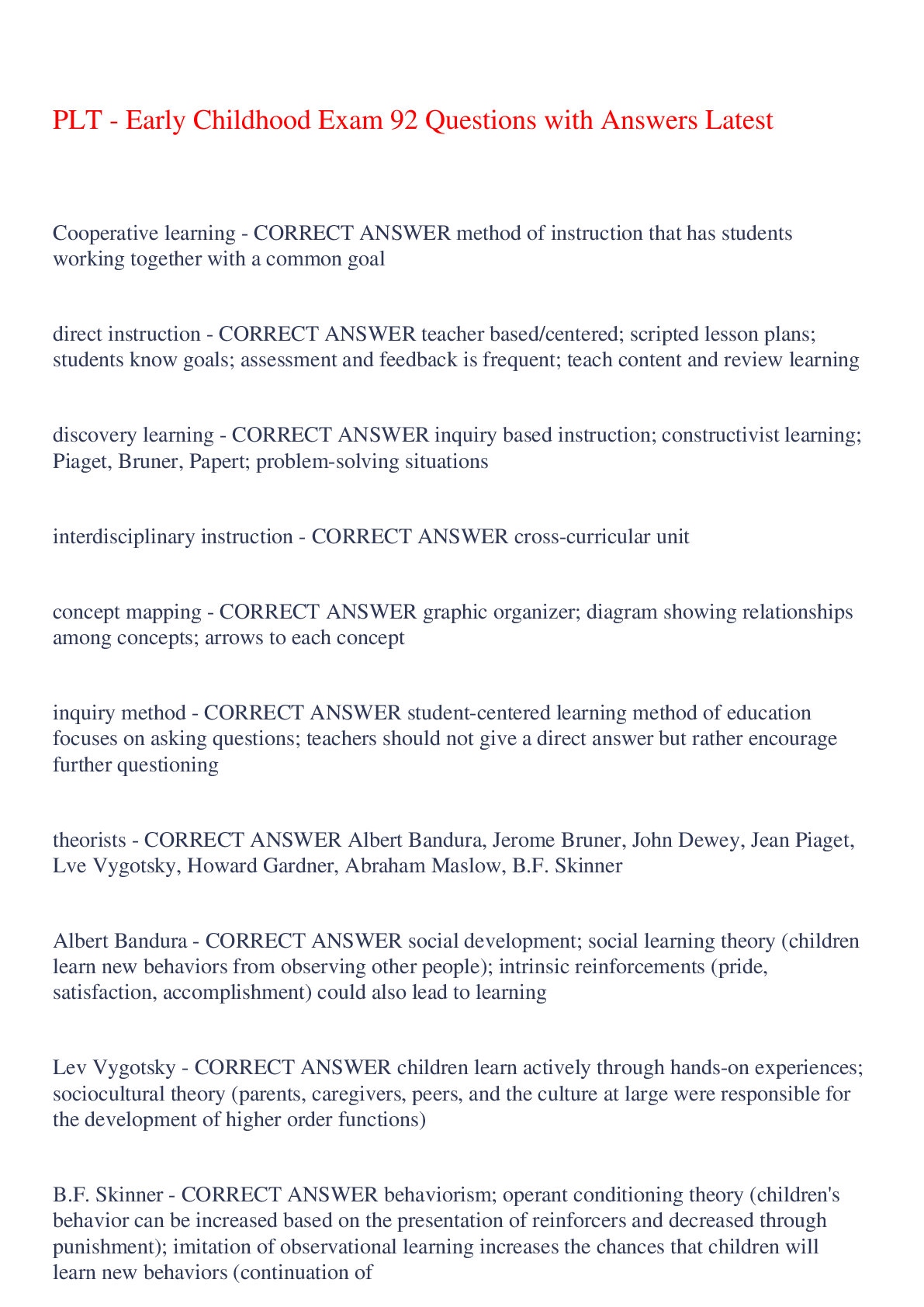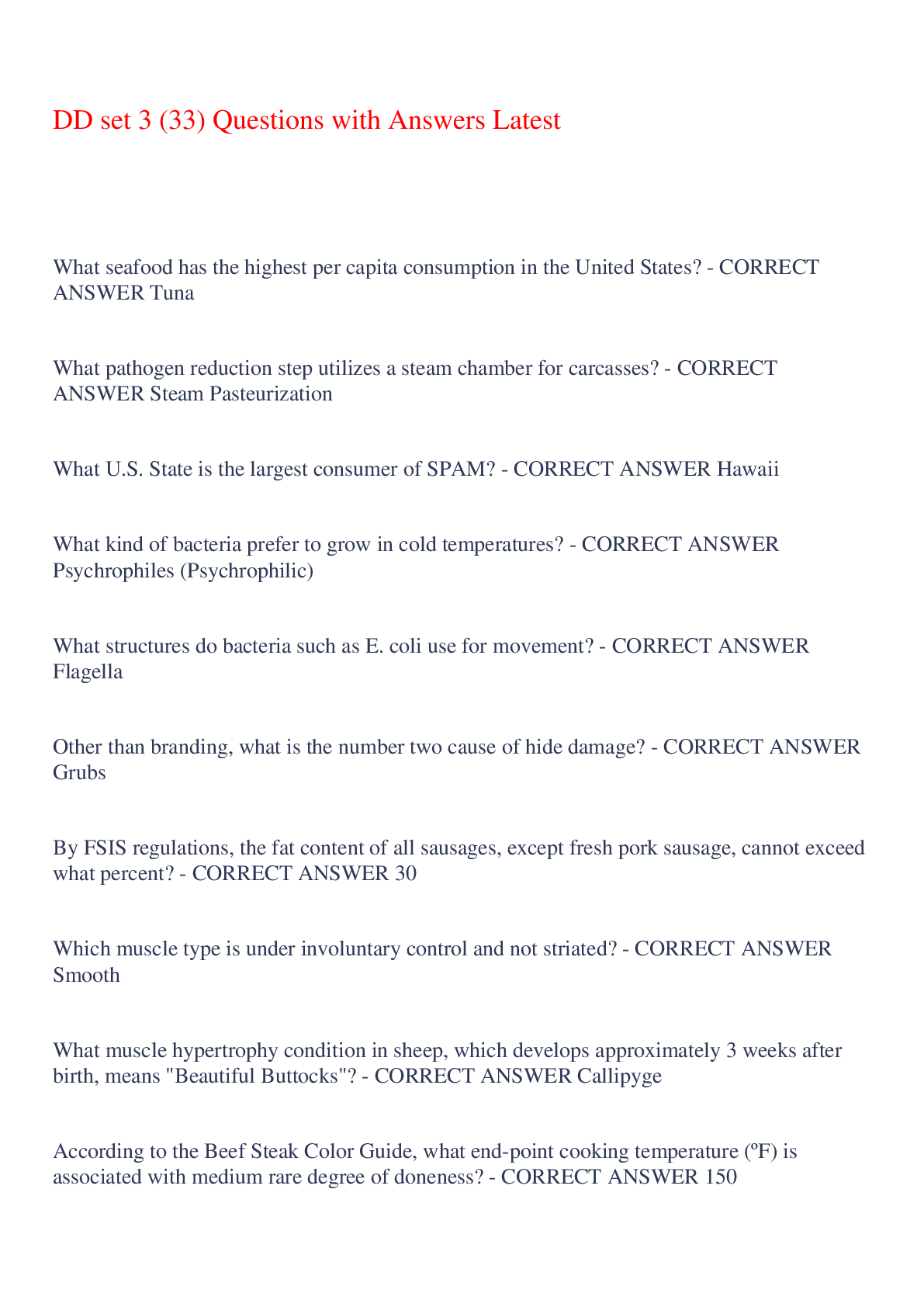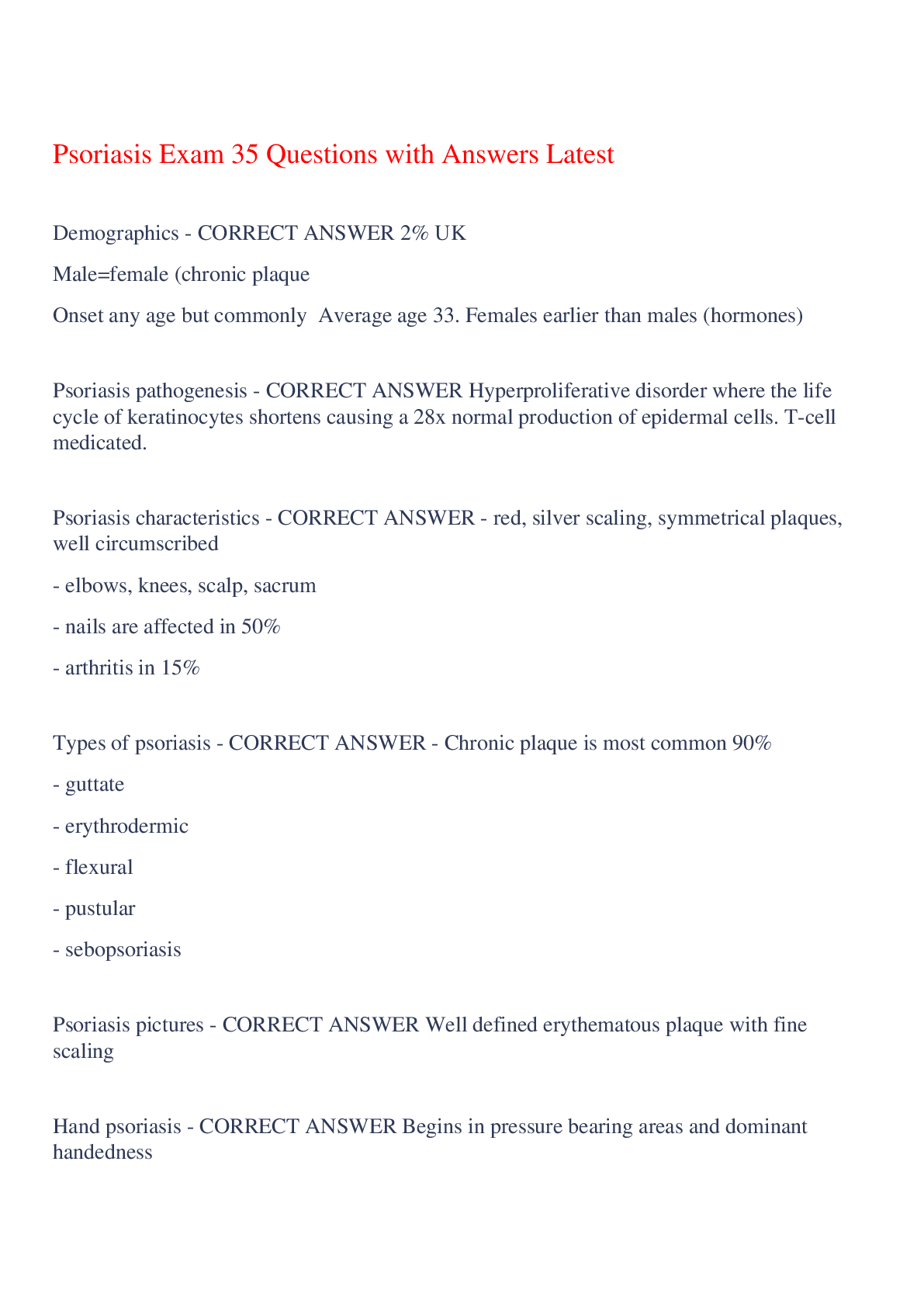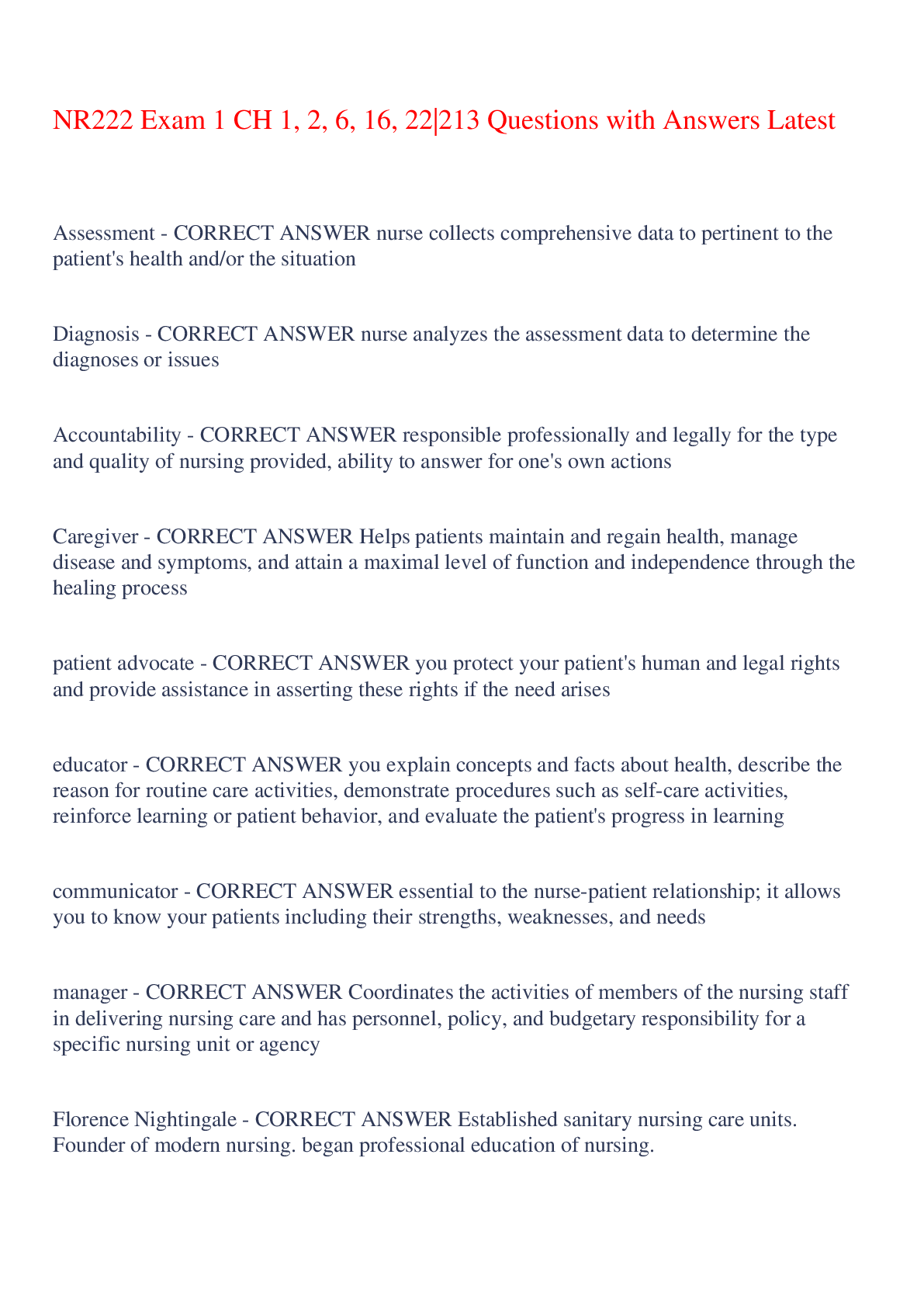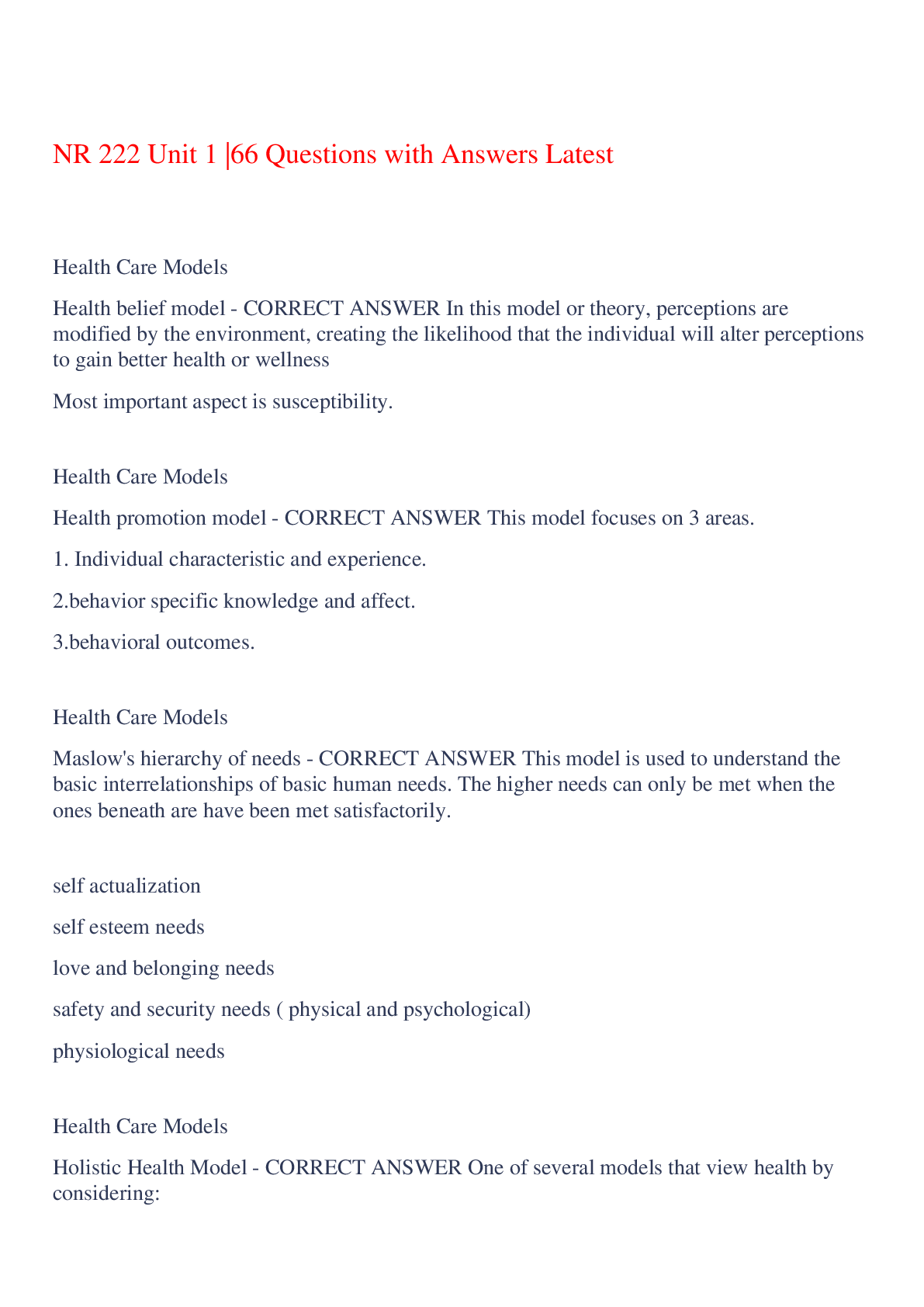Health Care > EXAM > NR 222 Exam 1|124 Questions with Answers latest,100% CORRECT (All)
NR 222 Exam 1|124 Questions with Answers latest,100% CORRECT
Document Content and Description Below
NR 222 Exam 1|124 Questions with Answers latest What is Nursing? - CORRECT ANSWER Care is provided according to standards of practice and a code of ethics What do Nurses do? - CORRECT ANSWER ... -Respond to needs of patients -Actively participate in policy -Respond and adapt to challenges -Make clinical judgments and decisions about patients' health care needs based on knowledge, experience, and standards of care What was Clara Barton - CORRECT ANSWER Founded the American Red Cross What was Dorothea Lynde Dix - CORRECT ANSWER Supervisor of female nurses in the Union Army Who was Mother Bickerdyke - CORRECT ANSWER Organized emergency services and nurses in the civil war Who was Mother Hubbard - CORRECT ANSWER Prohibitionist Who was Harriet Tubman - CORRECT ANSWER Prominent female in the Underground Railroad movement to free slaves What was Mary Mahoney - CORRECT ANSWER First professionally educated African-American Who was Isabel Hampton Robb - CORRECT ANSWER Founded the American Nurses Association in 1911 Who was Lillan Wald and Mary Brewster - CORRECT ANSWER Henry Street Settlement- founders of public heath The Twentieth Century: Movement toward scientific, research-based practice and defined body of knowledge - CORRECT ANSWER 1901: Army Nurse Corps established 1906: Mary Adelaide Nutting, first professor of nursing at Columbia University 1908: Navy Nurse Corps established 1920-1923: Study of nursing education 1940-1950s: Associations emerged 1970: Emergency room nurses organization What was developed in the the twenty-first century - CORRECT ANSWER -Nursing code of ethics -Changes in curriculum -Nursing in multiple care settings -Advances in technology and informatics -End of life care Influences on Nursing: Changes in society lead to changes in nursing - CORRECT ANSWER -Health care reform -Demographic changes -Medically underserved -Threat of bioterrorism -Rising health care costs -Nursing shortage Nursing as a Profession: A profession has characteristics - CORRECT ANSWER -Requires an extended education -Requires a body of knowledge -Provides a specific service -Has autonomy -Incorporates a code of ethics Professional Responsibilities: Then and now - CORRECT ANSWER -Nurses are responsible for obtaining and maintaining specific knowledge and skills ~In the past: To provide care and comfort ~Now: To provide care and comfort and to emphasize health promotion and illness prevention Nursing Practice: Nurses practice in a variety of settings - CORRECT ANSWER -Protect, promote and optimize our patients -Prevent illness and injury -Alleviate suffering through the diagnosis and treatment of human responses -Advocate for the care of our patients Benner's stages of nursing proficiency - CORRECT ANSWER -Novice -Advance beginner -Competent -Proficient -Expert Scope and Standards of Practice - CORRECT ANSWER Nursing: Scope and Standards of Practice -1960: Documentation began -Standards of Practice -Standards of Professional Performance Goal: -To improve the health and well-being of all individuals, communities, and populations through the significant and visible contributions of registered nursing using standards-based practice The ANA Scope and Standards - CORRECT ANSWER -The ANA scope and Standards guides nursing practice and gives an extensive description of the art and science of nursing. -It also provides direction for registered nurses throughout the nation and helps define values and priorities -If a nurse is accused of inappropriate professional behavior or malpractice, the ANA Standards of Practice is one of the tools used to determine whether the allegations are true Six Standards of practice - CORRECT ANSWER -Assessment -Diagnosis -Outcomes identification -Planning -Implementation -Evaluation Code of Ethics - CORRECT ANSWER -A code of ethics is the philosocphical ideals of right and wrong that define principles used to provide care. -It is important for you to incorporate your own values and ethics into your practice -Ask yourself: How do your ethics, values, and practice compare with established standards? Autonomy - CORRECT ANSWER Professional autonomy means having the authority to make decisions and the freedom to act in accordance with one's professional knowledge base. Nursing is defined as a profession because nurses... - CORRECT ANSWER Practice autonomy Quality and Safety Education for Nurses (QSEN) - CORRECT ANSWER Competency: -Patient-Centered Care -Teamwork and Collaboration -Evidence-based Practice -Quality Improvement -Safety -Informatics The Joint Commission(TJC) - CORRECT ANSWER -Accredits health care organizations across the continuum of care -Earned by the entire organization -Demonstrates quality and safety in the delivery of care and to evaluate the performance based on established standards HIPAA - CORRECT ANSWER Health Insurance Portability and Accountability Act Professional Nursing Organizations - CORRECT ANSWER -National League for Nursing (NLN) -American Nurses Association (ANA) -International Council of Nursing (ICN) -National Student Nurses Association (NSNA) or Canadian Student Nurses Association (CNSA) The NLN and the ANA are professional organizations that deal with - CORRECT ANSWER -Nursing issues of concern -Political and professional issues affecting health care -Financial issues affecting health care -All of the above issues What are the reasons that we are studying Health Promotion - CORRECT ANSWER -Nurses following Newman's model of care -Concepts of Quality vs Quantity of life are valuable to use. -What will the last ten years look like. Wellness-illness continuum - CORRECT ANSWER Health as dichotomy: High-level wellness vs. Depletion of health High-level wellness - CORRECT ANSWER Sense of well-being, life satisfaction, quality of life Negative end - CORRECT ANSWER Adaption to disease/ disability Exploring Concepts of Health - CORRECT ANSWER -Wellness-illness continuum -High-level wellness -Negative end Wellness-Illness - CORRECT ANSWER -Moving from the center to the left shows progressivley worsening state of health -Moving to the right of center indicates increasing levels of health and wellbeing -The treatment paradigm (drugs, herbs surgery, psychotherapy, acupuncture and so on) can bring you up to the neutral point, where the symptoms of disease have been alleviated -The wellness paradigm, which can be utilized at any point on the continuum, helps you move towards higher levels of wellness High Level Wellness - CORRECT ANSWER -Sense of well-being, life satisfaction, quality of life -Interrelationship between environment and person -Terminal disease and be emotionally prepared for death Definition of Health - CORRECT ANSWER -Health is more than the absence of diseases -A state of complete physical, mental and social well-being, not merely the absence of disease or infirmity -A state of being that people define in relation to their own values, personality and lifestyle Key Health Concepts: Functioning - CORRECT ANSWER Levels reflected in terms of performance/social expectations; loss indicator of need for nursing intervention Key Health Concepts: Health - CORRECT ANSWER -State of physical, mental, spiritual and social functioning within developmental context -Both individual and societal responsibility Key Heath Concepts: Disease - CORRECT ANSWER -Failure of adaptive mechanisms -Results in functional or structural disturbances Key Health Concepts: Illness - CORRECT ANSWER Subjective experience of individual and physical manifestation of disease Models of Health: Health Belief Model - CORRECT ANSWER Addresses the relationship between a person's beliefs and behaviors Models of Health: Health Promotion Model - CORRECT ANSWER Directed at increasing a patient's level of well-being Models of Health: Holistic Health Model - CORRECT ANSWER Attempts to create conditions that promote optimal health Maslow's Hierarchy of Needs - CORRECT ANSWER -Basic human needs are elements for survival (food, water, safety, love) -Each person is unique but shares the basic human needs -The level of the needs being met is the major factor to determine the level of health -Basic needs must be met before higher learning What is Maslow's Hierarchy of needs from lowest to highest - CORRECT ANSWER -Physiological needs (food, sleep, sex, shelter) -Safety needs -Belonging -Esteem -Self actualization Transtheoretical Model of Health Promotion - CORRECT ANSWER Example of health promotion model Incorporates: -Stages of change -Decisional balance -Self-efficacy -Processes of change -Six stages- each provides nursing opportunity for information and support Ecological Model of Health - CORRECT ANSWER -Comprehensive and multidimensional -Interconnection between people and physical/social environments -Promotes health on multiple levels: Individual, family, community and society According to Maslow's hierarchy of needs, which of these needs would the patient seek to meet first? - CORRECT ANSWER Shelter Variables Influencing Health and Health Beliefs and Practices - CORRECT ANSWER -Variables influence how a person thinks and acts -Health beliefs can negatively or positively influence health behavior or health practices -Health beliefs and practices are influence by internal and external variables and should be considered when planning care. internal Variables - CORRECT ANSWER Developmental Stage -Intellectual Background -Perception of Functioning -Emotional Factors -Spiritual Factors External Variables - CORRECT ANSWER -Family Practices -Socioeconomic Factors -Cultural Background After evaluating a patient's external variables, the nurse concludes that health beliefs and practices can be influenced by: - CORRECT ANSWER A. emotional factors B. Intellectual background c. Developmental Stage D. Socioeconomic Factors D You will use the concept of primary prevention when instructing a patient to - CORRECT ANSWER A. Get a flu shot every year B. Take a blood pressure reading everyday C. Explore hiring a patient with a known disability D. Undergo physical therapy following a cerebrovascular accident A Risk Factors - CORRECT ANSWER -variables that increase the vulnerability of an individual or a group to an illness or accident -Risk factors include: -Genetic and physiological factors -Age -Environment -Lifestyle Risk Factor Modification and Changing Health behaviors: Stages - CORRECT ANSWER Precontemplation -Not intending to make changes within the next 6 months Contemplation -Considering a change within the next 6 months Preparation -Making small changes in preparation for a change in the next month Risk Factor Modification and Changing Health Behaviors - CORRECT ANSWER -Improvement in health may involve a change in health behaviors -Action -Actively engaged in strategies to change behavior; last up to 6 months -Maintenance stage -Sustained change overtime; begins 6 months after action has started and continues indefinitely Illness - CORRECT ANSWER -A state in which a person's physical, emotional, intellectual, social, developmental or spiritual functioning is diminished or impaired -Acute Illness: short duration and severe -Chronic Illness: Persists longer than 6 months Sally has decided to set aside 30 minutes a day to walk after work next week. Sally is in what stage of risk factor modification? - CORRECT ANSWER A. Precontemplation B. Contemplation C. Preparation D. Action E. Maintenance C Illness Behavior - CORRECT ANSWER -Involves how people monitor their bodies and define and interpret their symptoms -Influenced by many variables and must be considered by the nurse when planning care -Internal variable: Perception of illness and nature of illness - External variables: Visibility of symptoms, social group, cultural background, economics and accessibility to health care Impact of illness on the patient and family - CORRECT ANSWER -Behavioral and emotional changes -Impact on body image -Impact on self-concept -Impact on family roles -Impact on family dynamics Self-Concept - CORRECT ANSWER -A subjective sense of self and a complex mixture of unconscious thoughts, attitudes, and perceptions -A positive self-concept gives a sense of meaning, wholeness and consistency to a person -A healthy self-concept has a high degree of stability and generates positive feelings toward the self. -Self-esteem is closely related Components of Self-Concept - CORRECT ANSWER -Identity -Body Image -Role performance Components of Self-Concept: Identity - CORRECT ANSWER Involves the internal sense of individuality, wholeness, and consistency of self Components of Self-Concept: Body Image - CORRECT ANSWER Involves attitudes related to physical appearance, structure or function Components of Self-Concept: Role Performance - CORRECT ANSWER How individuals carry out their significant roles Factors Affecting Self-Concept - CORRECT ANSWER -Any real or perceived change that threatens identity, body image, or role performance can affect self-concept -Changes that occur physical, spiritual, emotional, sexual, familial, and sociocultural health affect self-concept. -change in health -Other crises You are assigned to care for a patient who has just undergone a mastectomy for a malignant tumor. You would most appropriately classify this self-concept component as - CORRECT ANSWER A. Identity stressor B. Sexuality Stressor C. Body image Stressor D. Role performance stressor C The Nurse's Effect on the Patient's Self-Concept - CORRECT ANSWER Nurses need to remain aware of their own feelings, ideas, values, expectations and judgments: -Use a positive and matter of fact approach -Build a trusting relationship -Be aware of facial and body expressions Older-Adult Self- Concept - CORRECT ANSWER -Can be negatively affected in older adulthood because of a number of life changes -However, in some individuals, aging promotes improved coping strategies that protect against declining feelings of self-esteem, despite the physical and emotional changes associated with aging -Nursing interventions aimed at enhancing self-concept and self-esteem in older adults are essential You are caring for an adolescent patient who has undergone a gastric banding procedure 6 months previously. This adolescent tells you, " there is still a fat person inside of me." This type of statement illustrates a flaw in the self-concept of - CORRECT ANSWER A. Identity B. Self-esteem C. Body image D. Role performance C Cultural Considerations - CORRECT ANSWER -Develop an open. nonrestrictive attitude for assessing and encouraging cultural practices to improve patient's self-concept -Ask patients what they think is important to help them feel better or gain a stronger sense of self. -Encourage cultural identity by individualizing self-care practices and offering treatment choices to meet patients' self-concept needs. -Facilitate culturally sensitive health promotion activities that address at-risk behaviors identified through evidence-based practice. You are assigned to care for a patient who retired 6 months ago. While providing care, you identify that this patient is struggling emotionally with change. This situation is most likely associated with the self-concept component of - CORRECT ANSWER A. Identity stressor. B.Sexuality stressor. C. Body image stressor. D. Role performance stressor D Historical Perspective of Health : Before 1940 - CORRECT ANSWER Absence of disease -Infectious diseases prominent -Physician: independent primary practitioner -Government: start public health/welfare Historical Perspective of Health: 1940s-1950s - CORRECT ANSWER -Ability to fulfill roles -Physicals for fitness -Physicians linked to hospital services -Increased federal role: hospital expansion, federal programs Historical Perspective of Health: 1960s-present - CORRECT ANSWER Adaptation and reaction to environment -Disease prevention/health promotion -Emphasis on individual responsibility/lifestyle choices -Growing number/diversity of primary providers -Government: control costs -Quality of life seen as component of health Patient/family perception important Exploring Concepts of Health: Unitary patterning of person-environment (1970s and 1980s) - CORRECT ANSWER -Unidirectional -Developmental -Expanding consciousness, pattern/meaning recognition -Health outcome of ongoing patterns person/environmental interaction -Person is a complex, interconnected system Models of health - CORRECT ANSWER -Clinical -Role performance -Adaptive -Eudemonistic model Models of Health: Clinical - CORRECT ANSWER -Absence of disease; prevention not emphasized -Health is defined by the absence of signs/symptoms of disease -Illness is defined by the presence of sign and symptoms of disease -No preventative care -Conventional medicine Models of Health: Role Performance - CORRECT ANSWER -Health based on whether person can perform societal roles -Health is the ability to perform social roles -Illness would be the failure to perform roles at the level of others in society -"sick role" Models of Health: Adaptive - CORRECT ANSWER -Ability to adapt positively to change -Health is defined as the ability to adjust positively to social, mental, and physiological change. This is the measure of health -illness occurs when the person fails to adapt or becomes maladaptive when change occurs. -Example=spirituality in older adults Models of Health: Eudaimonistic Model - CORRECT ANSWER -Optimal health is defined as exuberant well-being. There is an emphasis between physical, social, psychological and spiritual aspects of life. The environment increases meaning in this model. -illness is defined as lack of involvement with life -This model is congruent with integrative modes of therapy- National Center for Complementary and Alternative Medicine -Actually predates clinical model -A person dying of cancer may still be healthy if they have meaning in life in this model of health. Global Health - CORRECT ANSWER The World Health Organization's (WHO) overriding objective is to influence health opportunities and outcomes for all people so that they can attain the highest possible level of health. US Health Trends - CORRECT ANSWER -Successes in infection, other diseases -Concerns: Sedentary lifestyle, obesity, chronic illness -Health disparities persistent -Contribute to unfavorable US health indicators -Compromise progress in world health -Vulnerable population due to age, education, language, location -Work environment changes identified for a safer US health care system Health of the Nation- The US population as a whole - CORRECT ANSWER Our Issues: -Unequal access to healthcare -Recent economic decline -High unemployment rates -Vulnerable populations Vulnerable Populations in the US - CORRECT ANSWER -Residents of rural areas -Undocumented immigrants -Low-income individuals and families -Racial and ethnic minorities -People with multiple chronic conditions -People with no health insurance -People with language barriers -Disabled or handicapped -Terminally or mentally ill -HIV/AIDS -And more The Health of the Nation - CORRECT ANSWER -Health, United States report -Informs policy makers of trends in nation's health -Healthy people 2020 -Goal is to increase quality and years of healthy life, and eliminate health disparities -World Health Organization (WHO) statistics -Morbidity data -Compares United States with other countries Healthy People 2020: National Guidelines to Promote Health - CORRECT ANSWER -Define national emphasis for health promotion and disease prevention efforts -Four overarching goals- Guide for healthcare research, practice, education, policy and communications -Attain high quality, longer lives free of preventable disease, disability, injury and premature death. -Achieve health equity, eliminate disparities and improve the health of all groups -Create social and physical environments that promote good health for all -Promote quality of life, healthy development and healthy behaviors across all life stages Focus Areas for Healthy People 2020 - CORRECT ANSWER -Adolescent Health -Blood Disorders and Blood Safety -Dementia, including Alzheimer's Disease -Early and Middle Childhood -Genomics -Global Health -Healthcare-Associated Infections -Health-Related Quality of Life and Well-being -Lesbian, Gay, Bisexual, and Transgender Health -Older Adults -Preparedness -Sleep Health -Social Determinants of Health The Nurse's Role - CORRECT ANSWER -Emphasis shifting from acute, hospital care to preventative community-based care -Nurses must assume blended roles with a knowledge base using evidence-based practice Evidence-Based Practice - CORRECT ANSWER -Conscientious, explicit, and judicious use of current best evidence in making decisions about the care of individual patients -Integrating individual clinical expertise with the best available external clinical evidence from systematic research (ANA, 2004) Nursing Roles in Health Promotion and Protection - CORRECT ANSWER -Advocate- everyone gets care -Care manager- gatekeeper of services, collaborate -Consultant- provide knowledge, expertise -Deliverer of services- perform skills -Educator- help patients apply knowledge -Healer- balance, care, touch -Researcher- EBP Examples of Health Services Across the Continuum: Primary Care - CORRECT ANSWER -Health promotion -Prenatal and well-baby care -Nutritional counseling -Family planning -Exercise classes Examples of Health Services Across the Continuum: Preventative Care - CORRECT ANSWER -Blood pressure and cancer screening -Immunizations -Mental health counseling and crisis prevention -Community legislation Examples of Health Services Across the Continuum: Secondary Acute Care - CORRECT ANSWER -Emergency care -Acute medical-surgical care -Radiological procedures -Acute problems (CT scans, x-rays) Examples of Health Services Across the Continuum: Tertiary Care - CORRECT ANSWER -Intensive care -Sub acute care Examples of Health Services Across the Continuum: Restorative Care - CORRECT ANSWER -Cardiovascular and pulmonary rehabilitation -Sports medicine -Spinal cord injury program -Home care Examples of Health Services Across the Continuum: Continuing Care - CORRECT ANSWER -Assisted living -Psychiatric and older adult day care Improving Prospects for Health - CORRECT ANSWER Population effects: -Increased diversity -Changes in age distribution (older population) -Health promotion approaches may need to adapt Shifting problems: -Environmental pollution -Stress -Lifestyle (obesity, substance abuse) -Increase in chronic conditions Moving toward solutions: -Individual involvement (lifestyle changes, motivation) -Governmental involvement (legislation and financing) Split Between Preventative and Curative Measures - CORRECT ANSWER Early prevention: -Within medical practice -Focus on poor Development of preventative services: -Within public health -Incorporated clinical medicine (immunizations, screenings) Evolution: Emphasis on societal values: -Government involvement in financing -Health care reform efforts to address health care barriers Levels of Prevention and Steps of prevention - CORRECT ANSWER Primary: 1. Health promotion and specific protection Secondary: 1. Early diagnosis 2. Prompt treatment 3. Disability limitation Tertiary: 1. Restoration and rehabilitation Levels of Prevention - CORRECT ANSWER Primary: True prevention that lowers the chances that a disease will develop Secondary: Focuses on those who have a disease or are at risk to develop a disease Tertiary: Occurs when a defect or disability is permanent or irreversible Primary prevention - CORRECT ANSWER -Precedes disease/dysfunction -Interventions: -Health promotion (e.g., education) -Specific protection (e.g., immunization, reducing exposure to carcinogens, occupational hazards) -Focus: Maintain/improve general individual/family/community health -Passive-not personally involved: -Public health efforts-clean water/sewer -Active-personally involved: -Lifestyle changes Secondary Prevention - CORRECT ANSWER -Screening -Goal: Identify individuals in early, detectable stage of disease -Treating early stages of disease -Limiting disability -Interventions similar to primary prevention but applied to individuals/ populations with disease Tertiary Prevention - CORRECT ANSWER -Defect/disability permanent or irreversible (e.g., stroke) -Minimizing effect to prevent complications/deterioration -Objective: Return to useful place in society, maximize remaining capacity: -Surveillance -Maintenance -Rehabilitation Organization of the Delivery System: Private Sector -Independent practice - CORRECT ANSWER Independent practice -Fee for service; choice of provider -Primary care—comprehensive, prevention emphasis Organization of the Delivery System: Private Sector -Nursing managed centers - CORRECT ANSWER -Advanced Practice Nurse as primary care provider (PCP) -Multidisciplinary collaborative approach -Focus: Vulnerable populations Organization of the Delivery System: Private Sector -Managed health care/health maintenance organization - CORRECT ANSWER -Groups of providers, contract with HMOs -Comprehensive care for prepaid fee Organization of the Delivery System: Private Sector Managed care characteristics - CORRECT ANSWER -Control costs, regulate health care utilization -PCP gatekeeper to system; coordinate care -Payment amount dependent on provider (within/outside of network) Organization of the Delivery System: Private Sector -Independent practice associations - CORRECT ANSWER -Physician organizations -Care for HMO members in private office -Several models available Organization of the Delivery System: Private Sector -Concierge medical practices - CORRECT ANSWER -Membership fee for enhanced health care -Fewer patients; more time/patient -Focus: Personalized care for upper SES Organization of the Delivery System: Private Sector -Hospitalist movement - CORRECT ANSWER Physicians: Care for hospitalized patient Organization of the Delivery System: Private Sector -Point of service plans (POS) - CORRECT ANSWER -Additional fee for providers outside of network -Increases consumer choice Organization of the Delivery System: Private Sector -High Deductible Health Insurance Plans - CORRECT ANSWER -Feature a very high annual out-of-pocket deductible of $1000 to $2000 for individual coverage with a low monthly premium -Structured similar to traditional managed care plans and fee-for-service plans Organization of the Delivery System: Private Sector -Preferred Provider Organizations (PPO) - CORRECT ANSWER -Contracted providers provide services for discounted price -Additional consumer cost if non-PPO provider Healthcare delivery systems can be compared to a three-legged stool - CORRECT ANSWER -Each leg represents one of three critical elements of healthcare: cost, access, and quality -When any one or more of the legs predominates, then the stool gets off balance and the health of the population suffers. Medicare Part A - CORRECT ANSWER -Inpatient hospital care, skilled nursing facilities (not long term care), home health care, hospice Medicare Part B - CORRECT ANSWER -Supplementary voluntary coverage -Pays doctor's visits, outpatient services, preventative services -Home health visits Medicare Part D - CORRECT ANSWER -Pharmaceutical costs-multiple plans available -Work to gradually eliminate the prescription gap known as "Donut Hole" SOAP - CORRECT ANSWER Subjective Objective Assessment Plan SMART GOAl - CORRECT ANSWER Smart Measurable Attainable Realistic Timely Nursing Process ADPIE - CORRECT ANSWER Assessment Diagnosis (Nursing) Planning of care (SMART Goals) Implementation Evaluation How to write - CORRECT ANSWER -Pick a DX (diagnosis) -Related to Factors -As evidenced by: __________________related to _________as evidence by Gordon's Framework - CORRECT ANSWER -Concept of functional patterns and pattern interaction -Depicts individual's lifestyle Definition -Individual viewed as a whole being -Interrelated behavioral areas Gordon's health model: 11 Functional areas - CORRECT ANSWER -Health perception, health management pattern -Nutritional Metabolic Pattern -Elimination Pattern -Activity Exercise Pattern -Sleep Rest Pattern -Cognitive Perceptual Pattern -Roles Relationships Pattern -Sexuality Reproductive Pattern -Coping-Stress Tolerance Pattern -Values Beliefs Pattern [Show More]
Last updated: 1 year ago
Preview 1 out of 24 pages
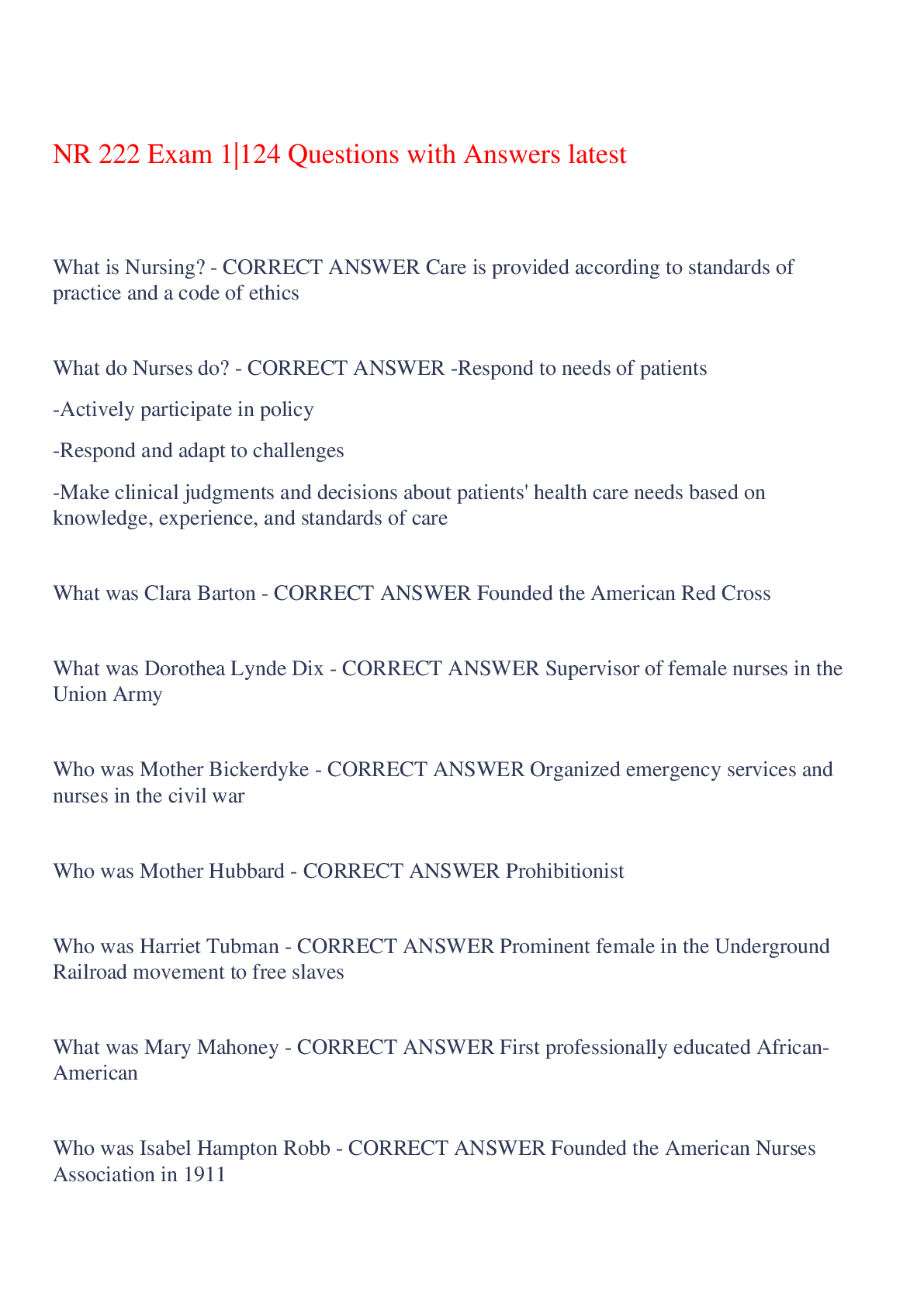
Buy this document to get the full access instantly
Instant Download Access after purchase
Add to cartInstant download
We Accept:

Reviews( 0 )
$6.50
Document information
Connected school, study & course
About the document
Uploaded On
May 19, 2023
Number of pages
24
Written in
Additional information
This document has been written for:
Uploaded
May 19, 2023
Downloads
0
Views
40













